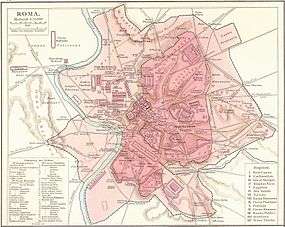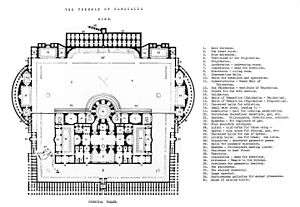Baths of Caracalla
| Latin: Thermae Antoninianae | |
|
| |
 Baths of Caracalla The location of the Baths in Rome during Antiquity | |
| Alternate name | Italian: Terme di Caracalla |
|---|---|
| Location | Rome, Italy |
| Region | Regione XII Piscina Publica |
| Coordinates | 41°52′45.998″N 12°29′35.002″E / 41.87944389°N 12.49305611°ECoordinates: 41°52′45.998″N 12°29′35.002″E / 41.87944389°N 12.49305611°E |
| Type | Thermae |
| Part of | Ancient Rome |
| Area | 100,000 m2 (1,100,000 sq ft) |
| Volume | 8,000,000 L (1,800,000 imp gal; 2,100,000 US gal) (baths' waters)[1] |
| Height | 40 m (130 ft)[1] |
| History | |
| Builder | Caracalla |
| Material | Marble, pozzolana, lime, tuff, basalt |
| Founded | 212-218 A.D. |
| Abandoned | 537 A.D. |
| Periods | Imperial |
| Site notes | |
| Condition | Poor |
| Public access | Limited |
| Architecture | |
| Architectural styles | Ancient Roman |
| Official name | Baths of Caracalla |
| Type | Cultural, artistic, historical, architectural, religious |
| Criteria | i, ii, iii, iv, vi |
| Designated |
|
| Part of | Historic Centre of Rome, the Properties of the Holy See in that City Enjoying Extraterritorial Rights and San Paolo Fuori le Mura |
| Reference no. | 91ter |
| Documents | Historic Centre of Rome... |
|
List of ancient monuments in Rome | |
The Baths of Caracalla (Italian: Terme di Caracalla) in Rome, Italy, were the second largest Roman public baths, or thermae, built in Rome between AD 212 (or 211) and 217, during the reigns of Septimius Severus and Caracalla.[2][3] They would have had to install over 2,000 t (2,000 long tons; 2,200 short tons) of material every day for six years in order to complete it in this time. Records show that the idea for the baths were drawn up by Septimius Severus, and merely completed or opened in the lifetime of Caracalla.[4] This would allow for a longer construction timeframe. They are today a tourist attraction.
History


The baths remained in use until the 6th century when the complex was taken by the Ostrogoths during the Gothic War, at which time the hydraulic installations were destroyed.[5] The bath was free and open to the public. The earthquake of 847 destroyed much of the building, along with many other Roman structures.
The building was heated by a hypocaust, a system of burning coal and wood underneath the ground to heat water provided by a dedicated aqueduct. It was in use up to the 19th century. The Aqua Antoniniana aqueduct, a branch of the earlier Aqua Marcia, by Caracalla was specifically built to serve the baths. It was most likely reconstructed by Garbrecht and Manderscheid to its current place.
In the 19th and early 20th century, the design of the baths was used as the inspiration for several modern structures, including St George's Hall in Liverpool and the original Pennsylvania Station (demolished in 1963) in New York City. At the 1960 Summer Olympics, the venue hosted the gymnastics events.
The baths were the only archaeological site in Rome damaged by an earthquake near L'Aquila in 2009.[6] They were again damaged, thought minorly, in August 2016 by an earthquake in central Italy.[7]

The baths were originally ornamented with high quality sculptures. Among the well-known pieces recovered from the Baths of Caracalla are the Farnese Bull and Farnese Hercules, now in the Museo Archeologico Nazionale, Naples; others are in the Museo di Capodimonte there. One of the many statues is the colossal 4 m (13 ft) statue of Asclepius.
Interior
The Caracalla bath complex of buildings was more a leisure centre than just a series of baths. The "baths" were the second to have a public library within the complex. Like other public libraries in Rome, there were two separate and equal sized rooms or buildings; one for Greek language texts and one for Latin language texts.
The baths consisted of a central frigidarium (cold room) measuring 55.7 by 24 m (183 by 79 ft) under three groin vaults 32.9 m (108 ft) high, a double pool tepidarium (medium), and a caldarium (hot room) 35 m (115 ft) in diameter, as well as two palaestras (gyms where wrestling and boxing were practiced). The north end of the bath building contained a natatio or swimming pool. The natatio was roofless with bronze mirrors mounted overhead to direct sunlight into the pool area. The entire bath building was on a raised platform 6 m (20 ft) high to allow for storage and furnaces under the building.[8]
The libraries were located in exedrae on the east and west sides of the bath complex. The entire north wall of the complex was devoted to shops. The reservoirs on the south wall of the complex were fed with water from the Marcian Aqueduct.[8]
Subterranean features
Discovered in 1912, the mithraeum at the Bath is considered the largest documented gathering space for the worshippers of Mithras, the Persian god in vogue with the military and mostly lower class men, in the second and third centuries AD. The mithraeum was approximately 23 m (75 ft) long and 10 m (33 ft) wide with a cross-vaulted ceiling. It can be only roughly dated by the two main events associated with the baths: the mithraeum was certainly created after the complex was completed in AD 217 and it was probably no longer in use when the aqueduct supplying the complex was cut during the Greco-Gothic Wars. Certainly the most intriguing feature is the small tunnel that runs under the center of the main hall into an adjoining room, where there is an entrance/exit with staircase; this has been identified as the fossa sanguinis, the ritual pit over which the bull at the center of the Mithraic mythology was slaughtered, bathing one or more initiates in its blood.[1][9]
Dimensions

Principal dimensions
- Precinct maximum: 412 m × 393 m (1,352 ft × 1,289 ft)
- Internal: 323 m × 323 m (1,060 ft × 1,060 ft)
- Central Block overall: 218 m × 112 m (715 ft × 367 ft)
- Swimming Pool: 54 m × 23 m (177 ft × 75 ft)
- Frigidarium: 59 m × 24 m (194 ft × 79 ft), height of 41 m (135 ft)
- Caldarium: 35 m (115 ft), height of 44 m (144 ft)
- Internal courts: 67 m × 29 m (220 ft × 95 ft)
Quantities of materials
- Pozzolana: 341,000 m3 (12,000,000 cu ft)
- Quick lime: 35,000 m3 (1,200,000 cu ft)
- Tuff: 341,000 m3 (12,000,000 cu ft)
- Basalt for foundations: 150,000 m3 (5,300,000 cu ft)
- Brick pieces for facing: 17.5 million
- Large Bricks: 520,000
- Marble columns in Central block: 252
- Marble for columns and decorations: 6,300 m3 (220,000 cu ft)
Estimated average labour figures on site
- Excavation: 5,200 men
- Substructure: 9,500 men
- Central Block: 4,500 men
- Decoration: 1,800 men
The 12 m (39 ft) columns of the frigidarium were made of granite and they weighed close to 100 t (98 long tons; 110 short tons).
Grounds
The bath complex covered approximately 25 ha (62 acres). The bath building was 750 m (2,460 ft) long, 116 ha (290 acres) wide and 38.5 ha (95 acres) estimated height, and could hold an estimated 1,600 bathers.[8]
Public use in culture
Opera and concerts
The central part of the bath complex is the summer home of the Rome Opera company. It is also a concert venue, having achieved fame as the venue and backdrop for the first Three Tenors concert in 1990.
Sporting
The area was used for the Rome Grand Prix four times between 1947 and 1951.[10][11]
Visiting
The extensive ruins of the baths have become a popular tourist attraction. The baths are open to the public for an admission fee. Access is limited to certain areas to avoid damage to the mosaic floors, although such damage is already clearly visible. Also, a total of 22 well-preserved columns from the ruins are found in the church of Santa Maria in Trastevere, taken there in the 12th century.
See also
References
- 1 2 3 Dowson, Thomas (22 November 2012). "Going Underground at the Baths of Caracalla - Archaeology Travel". Archaeology Travel. Retrieved 27 August 2016.
- ↑ "Ancient Roman Baths - Thermae, Baths of - Caracalla, Diocletian, Trajan - Crystalinks". www.crystalinks.com. Retrieved 27 August 2016.
- ↑ Scarre, Chris (1999). Scarre, Chris, ed. The Seventy Wonders of the Ancient World: The Great Monuments and How They Were Built (1st ed.). London: Thames & Hudson. p. 178. ISBN 9780500050965.
- ↑ Walker, Charles (1980). Wonders of the Ancient World. New York: Crescent Books. pp. 92–93. ISBN 9780517318256.
- ↑ http://www.rome-guide.it/english/monuments/monuments_caracalla.html
- ↑ "L'Aquila earthquake damaged ancient baths in Rome". The Telegraph. Telegraph Media Group Limited. 6 April 2009. Retrieved 27 August 2016.
- ↑ Kennedy, Maev (24 August 2016). "Art experts fear serious earthquake damage to historic Italian buildings". The Guardian. Retrieved 27 August 2016.
- 1 2 3 Roth, Leland M. (2007). Understanding Architecture: Its Elements, History, and Meaning (2nd ed.). Boulder, Colo.: Westview. ISBN 9780813390451.
- ↑ "Mithraeum at the Baths of Caracalla". American Institute for Roman Culture. 29 November 2012. Retrieved 27 August 2016.
- ↑ "More on Caracalla 1947". Caracalla 1947. Retrieved 27 August 2016.
- ↑ Architectural Record, Volumes 19-20. F.W. Dodge Corporation. 1906. p. 454. Retrieved 27 August 2016.
External links
| Wikimedia Commons has media related to Baths of Caracalla. |
- 1960 Summer Olympics official report. Volume 1. pp. 76, 79.
- 1960 Summer Olympic official report. Volume 2. Part 1. p. 345.
- Caracalla Thermal Baths
_pictogram.svg.png)